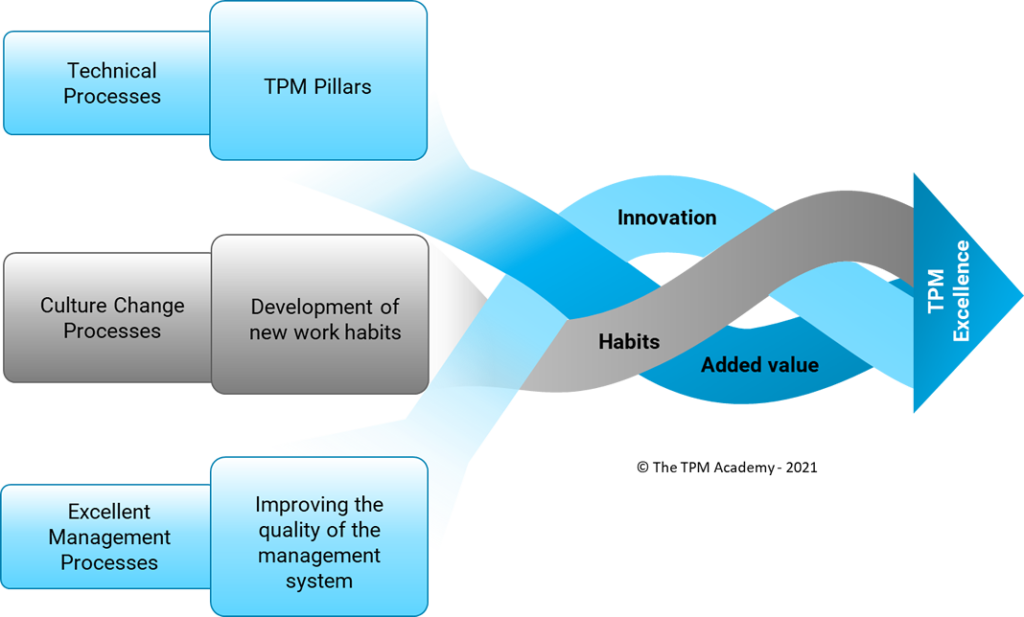TPM as an integrated process system
The TPM Academy editorial team
Understanding the processes that exist in TPM will facilitate the work of designing a master plan for implementation, taking into account the characteristics of the factory, the company’s human resources policies, and other transformation initiatives implemented in the past.
Professor Davenport of Harvard Business School considers a process as a structure for getting something done. Process is a set of interrelated or interacting activities that are ordered in time and place, having a beginning and an end. When these activities interact with each other, they produce an end result.
Under this definition, TPM can be structured as a system integrated by a set of processes, which perform different activities to produce a final result. The activities of the processes involved in TPM are varied and allow to achieve final results that are also varied. For example, in TPM there are processes that maximize equipment reliability. Other non-technical TPM processes facilitate people development, company culture transformation and change the way business operations are led and managed.
TPM process activities are carried out through stages or steps that are developed in a progressive and orderly manner over time. Each step serves an improvement purpose, has specific work methodologies, and produces a concrete observable end result, especially through the productivity results of the operations. In the following, we present a model of the general structure of existing TPM processes.
To facilitate the study of existing TPM processes, we have grouped them into three different but closely related categories:
(a) fundamental work or task processes, better known as TPM pillars,
b) processes for culture change, and
c) processes for improving the quality of factory management.
To successfully develop TPM in an industry, it is necessary to make decisions on how to structure these three types of processes. These decisions are conditioned by the strategic plans of the company’s operations, the type of industry, the existing culture in the factory, the current level of technological development, the progress made in maintenance systems, and other issues related to human resource policies.
Decisions about cultural change processes are the most complex to make, as they involve intangible factors such as the management styles used, company values, actions to vitalize workplaces, and other issues that are less familiar to factory managers than technical processes. The following chart shows the set of processes that make up the TPM activities.

Let’s first look at the fundamental or task-oriented processes. These are the TPM pillars and group together the actions necessary to achieve the highest levels of productivity, quality, agility, safety, and customer satisfaction. These task-oriented processes are responsible for improving the overall productivity of the company’s operations. The pillars have been suggested by the Japan Institute of Plant Maintenance (JIPM) but the following are the fundamental ones to start an implementation process in an industry: Autonomous Maintenance, Education and Training, Planned Maintenance, Early Maintenance, and Focused Improvement. Once these four pillars are introduced, other useful pillars can be introduced such as the quality maintenance pillar, TPM in operations support offices. In practice, companies implement the safety, health, and environment pillars at various points in time, depending on the degree of development of the factories in these areas.
With respect to culture change processes, these processes are not evident in the original model suggested by the JIPM, but are necessary to create an organization that enables the effective development of TPM. Internationally recognized organizations such as the Shingo Institute and the European Industrial Excellence Award propose alternatives for structuring the supporting processes. Processes related to the evolution of work culture are intended to develop new behaviors throughout the structure of an industry. Responsible autonomy, working in small teams, a culture of quality information, and the use of data to study and solve problems are examples of the new behaviors targeted by the development of these kinds of processes.
Processes that seek to improve the quality and effectiveness of management have been developed by companies taking from different sources the principles that help to strengthen the leadership and management of human teams so that they can achieve truly superior results. Possibly the essential distinction of these new management systems is the transformation of the traditional task management system, inherited from the command and control system, into a more effective one called commitment-centered management. Possibly one of the most relevant practices of the new management processes is the use of effective short conversations, the use of visual information on physical or digital boards, and the practice of self-management systems.
The development of a TPM project must consider the design of a plan that simultaneously integrates the actions to build and operate these three types of processes. An imbalance in the implementation of these processes will impede the achievement of goals, delay their execution, and demotivate teams.
